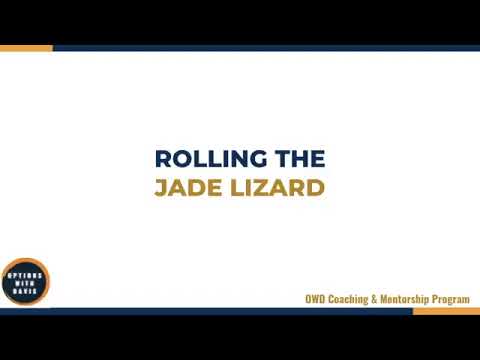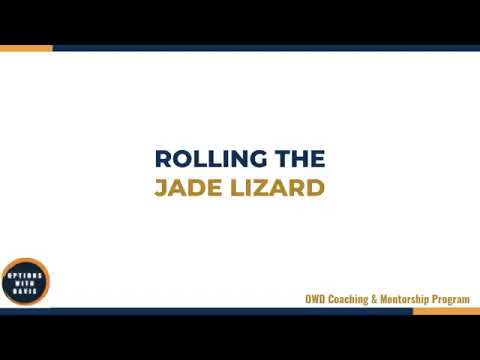Alright, let’s dive into the concept of rolling the Jade Lizard! Rolling the Jade Lizard is actually simpler than rolling the Iron Condor or the Strangle because there is no risk to the upside. If the market breaches the call spread, there’s no need to roll unless it breaches the put side. Before we get into the specifics, let’s go over some guidelines. You should only roll if your strikes get tested, meaning if they remain untested, you’re still in the profit zone. Additionally, make sure there’s more than 24 DTE (days to expiration) left, as you always want to exit at 21 DTE. It’s important to note that rolling down or up is preferable to rolling out in time because rolling out reduces the probability of the trade’s success. Keep in mind that our trading method already has an edge without rolling out, so when it’s time to take a loss at 21 DTE, we accept it. Now, let’s explore how to roll the Jade Lizard and understand the various scenarios that may arise.
Rolling the Jade Lizard
Rolling the Jade Lizard is a simple process that involves adjusting your positions when certain conditions are met. Unlike other strategies like the Iron Condor and the Strangle, there is no risk to the upside in the Jade Lizard. In this article, we will explore the guidelines for rolling and how to handle different market scenarios.
Guidelines for Rolling
Before diving into rolling the Jade Lizard, it is important to understand the guidelines for making adjustments. These guidelines will help you determine when to roll and when to leave the trade as is.
-
Roll if strikes get tested: If your strikes get tested, meaning the market breaches one of your short strikes, it may be necessary to roll your positions. However, if your strikes remain untested, you can leave the trade as is and let the strategy work.
-
Ensure there is more than 24 DTE: It is crucial to have more than 24 days to expiration (DTE) left in the trade before considering a roll. Exiting at 21 DTE is a general rule of thumb for most options strategies, including the Jade Lizard. If there are less than 3 days left, there is little benefit to rolling.
-
Roll only if there is a net credit after commissions: Rolling a position should ideally result in a net credit after accounting for transaction costs such as commissions. If there is no net credit or only a minimal credit, it may be better to exit the trade instead.
-
Avoid rolling out in time: While rolling out in time can give your trade more time to work out, it also lowers the probability of success compared to initially putting on the trade. Rolling out in time may lead to larger losses if the trade doesn’t go as planned. It is generally recommended to roll down or up instead of rolling out.
Rolling the Jade Lizard
Now that we understand the guidelines, let’s explore the specific scenarios for rolling the Jade Lizard.
Market Inside the Short Strikes
If the market is inside the short strikes, there is no immediate action required. The trade is still within the profit zone, and you can monitor it for potential adjustments in the future.
Market Breaches the Short Call Strike
When the market breaches the short call strike, there is no need to roll if your Jade Lizard was constructed with zero risk to the upside. In this case, there is already no risk to the upside, so rolling up the put side is unnecessary. Simply keep the trade as is and exit at 21 DTE. By that time, you should still be in a small profit.
However, if you choose to roll up the short put, make sure there is still more than 24 DTE remaining. Rolling up the put side adds more credit to the overall trade, which can lead to additional profits if the market continues to move up. Just keep in mind that rolling up the put side reduces the probability of profit. The break-even point will shift higher, potentially putting the trade at risk if the market suddenly turns downward.
Market Breaches the Short Put Side
If the market breaches the short put side, assess the remaining DTE. If there is less than 24 DTE, there is no immediate need to take action. However, if there is more than 24 DTE, rolling down the call spread is recommended.
Rolling down the call spread allows you to collect additional credit and potentially mitigate losses on the put side. It’s essential to maintain the size of the spread consistent. For example, if the spread is $2 wide, make sure to keep it at $2 when rolling down. Increasing the spread width introduces more risk, as the overall premium may not be sufficient to cover potential losses.
If the market continues to decline, you can choose to roll the call spread further down to generate more credit and absorb potential losses. Remember to exit the trade when it reaches 21 DTE.

Conclusion
Rolling the Jade Lizard is a straightforward process that involves adjusting your positions based on market conditions. By following the guidelines and understanding the specific scenarios for rolling, you can effectively manage your Jade Lizard trades. Remember to consider the risk-to-reward ratio and exit the trade when necessary to protect your capital. Good luck with your options trading journey!
